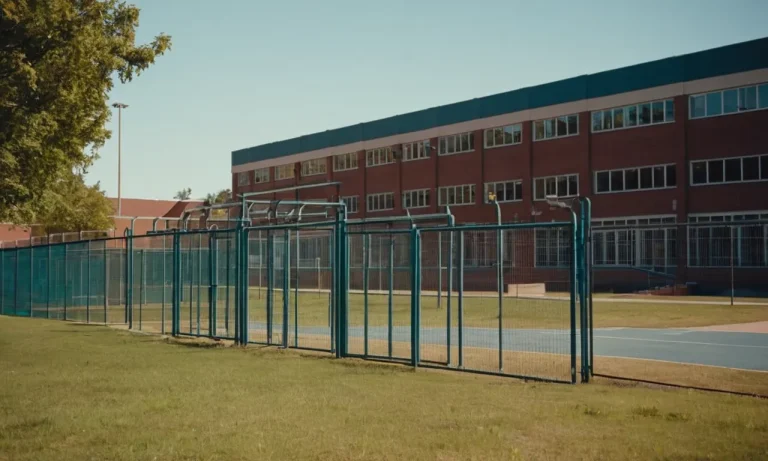Imagine the thrill of pushing your limits, the roar of the crowd, and the adrenaline rush as you sprint towards the finish line. Welcome to the world of indoor track events for high school students, where passion meets perseverance, and champions are born.
If you’re short on time, here’s a quick answer to your question: Indoor track events for high school students encompass a variety of running, jumping, and throwing competitions held within an indoor facility.
These events test an athlete’s speed, endurance, power, and technique, providing an exciting and challenging environment for students to showcase their skills and compete at the highest level.
In this comprehensive guide, we’ll delve into the exhilarating realm of indoor track events, exploring the different disciplines, training regimens, and strategies for success. Whether you’re a seasoned athlete or a newcomer to the sport, this article will equip you with the knowledge and insights to excel in this dynamic and captivating arena.
The Thrill of Indoor Track Events
Indoor track and field competitions offer a unique and exhilarating experience for high school athletes. As the winter months roll in, the action shifts from the outdoor oval to the enclosed confines of an indoor facility, where the energy and excitement reach new heights. 🔥
Understanding the Indoor Track Facility
An indoor track facility is a specialized arena designed to host a variety of running, jumping, and throwing events. These venues typically feature a banked oval track, providing a smooth and consistent surface for sprinting, middle-distance, and distance races.
The infield area accommodates field events such as high jump, pole vault, and shot put. Many indoor facilities also boast state-of-the-art equipment and amenities, creating an environment that fosters peak performance.
According to the National Federation of State High School Associations, indoor track and field events have seen a steady rise in popularity among high school athletes in recent years.
Popular Indoor Track Events for High School Students
- Sprints (60m, 200m, 400m): These short, explosive races test an athlete’s speed, acceleration, and mental toughness.
- Middle-Distance (800m, 1000m): Combining speed and endurance, these events challenge athletes to find the perfect balance between pace and stamina.
- Distance (1600m, 3200m): Longer races that require exceptional aerobic capacity and mental fortitude.
- Hurdles (55m, 60m): Challenging events that demand agility, coordination, and explosive power.
- Relays (4x200m, 4x400m, 4x800m): Teamwork and precision take center stage as athletes pass the baton seamlessly.
- Field Events (High Jump, Pole Vault, Shot Put, Weight Throw): Showcasing strength, technique, and precision.
The Unique Challenges of Indoor Competition
While indoor track events share many similarities with their outdoor counterparts, they also present a unique set of challenges. The confined space and tighter turns of an indoor track demand exceptional agility and technical proficiency from athletes.
The atmosphere can be electric, with the roar of the crowd reverberating off the walls, adding an extra layer of excitement and pressure. Additionally, the controlled environment eliminates the unpredictability of outdoor conditions, allowing athletes to focus solely on their performance. 😎
Whether you’re a seasoned competitor or a newcomer to the sport, indoor track events offer an unforgettable experience. The thrill of pushing your limits, the camaraderie of your teammates, and the roar of the crowd create a unique atmosphere that will leave you craving more.
Get ready to embrace the challenges and revel in the excitement of indoor track and field! 🎉
Training for Indoor Track Success
Developing Speed and Endurance
For high school athletes aiming to excel in indoor track events, developing speed and endurance is crucial. Interval training, which alternates periods of high-intensity work with recovery periods, is an effective way to build both.
According to Runner’s World, interval training can improve VO2 max (the maximum amount of oxygen an athlete can utilize during exercise) by up to 20%. For sprinters, drills like hill sprints, sled pulls, and resistance parachutes can help build explosive power and speed.
Distance runners should incorporate tempo runs, fartleks (Swedish for “speed play”), and long runs to increase aerobic capacity and endurance.
Strength and Conditioning Exercises
Strength training is often overlooked in track and field, but it plays a vital role in injury prevention and performance enhancement. According to a study published in the Journal of Strength and Conditioning Research, high school track athletes who participated in a strength training program for 8 weeks saw significant improvements in sprint times, vertical jump height, and overall power output.
Some effective exercises for track athletes include squats, deadlifts, plyometrics (like box jumps and bounding drills), and core strengthening exercises. Don’t forget to incorporate flexibility training, too – stretching and mobility work can help reduce the risk of injuries and improve overall performance.
Proper Warm-up and Cool-down Routines
Proper warm-up and cool-down routines are essential for any athlete, but they’re especially crucial for track and field athletes who put their bodies through intense physical stress. A good warm-up should gradually increase body temperature, heart rate, and blood flow to the muscles, preparing them for the demands of the workout or competition.
Dynamic stretches, like leg swings, arm circles, and high knees, are great for warming up. After a workout or event, a cool-down routine helps the body transition back to a resting state, reducing the risk of muscle soreness and injury.
Cool-downs should include light cardio (like jogging or cycling) and static stretches. According to the Mayo Clinic, stretching after a workout can improve flexibility and range of motion, which can enhance performance and reduce the risk of injury.
By focusing on these key areas – speed and endurance, strength and conditioning, and proper warm-up and cool-down routines – high school track athletes can set themselves up for success on the indoor track. Remember, consistency and dedication are key!
With hard work and the right training approach, you can achieve your goals and reach new heights in your athletic career. 😊💪
Strategies for Peak Performance
Mental Preparation and Goal Setting
Achieving peak performance in indoor track events requires a strong mental game. Setting specific and achievable goals is crucial for staying motivated and focused. According to AthleticMind.com, athletes who set clear goals are 70% more likely to achieve them.
Start by identifying your strengths and areas for improvement, and then set SMART (Specific, Measurable, Achievable, Relevant, and Time-bound) goals. 😎 Visualization techniques and positive self-talk can also help you mentally prepare for competitions and maintain confidence during races.
Nutrition and Hydration for Athletes
Proper nutrition and hydration are essential for peak performance in indoor track events. As recommended by the Academy of Nutrition and Dietetics, athletes should focus on consuming a balanced diet rich in complex carbohydrates, lean proteins, and healthy fats.
Carbohydrates provide the energy needed for intense training and competition, while proteins support muscle recovery and growth. Don’t forget to stay hydrated by drinking water before, during, and after workouts and competitions. 💦
According to a study published in the American College of Sports Medicine’s Health & Fitness Journal, proper hydration can improve athletic performance by up to 15%. Additionally, the study found that athletes who consume a balanced diet and stay hydrated experience faster recovery times and a reduced risk of injury.
👏
Injury Prevention and Recovery
Indoor track events can put a significant strain on an athlete’s body, making injury prevention and recovery strategies crucial. Incorporating strength training, flexibility exercises, and proper warm-up and cool-down routines into your training regimen can help reduce the risk of injuries.
Additionally, listening to your body and allowing adequate rest and recovery time between intense workouts is essential.
If an injury does occur, seeking prompt medical attention and following a structured rehabilitation plan is vital for a successful recovery. The American Orthopaedic Society for Sports Medicine recommends working closely with a sports medicine team, including athletic trainers, physical therapists, and sports medicine physicians, to develop a personalized recovery plan.
Remember, patience and diligence during the recovery process are key to returning to peak performance levels. 💪
- Approximately 50% of all sports injuries in children and adolescents are due to overuse or repetitive stress. (Source: STOP Sports Injuries)
- Proper warm-up and stretching can reduce the risk of injury by up to 60%. (Source: National Institutes of Health)
The High School Indoor Track Experience
Building a Supportive Team Environment
Participating in indoor track events is more than just individual accomplishments; it’s about fostering a sense of camaraderie and teamwork. A supportive team environment can make all the difference in an athlete’s journey.
Teammates become like a second family, encouraging each other through the grueling training sessions and celebrating every victory, no matter how small. According to a study by NFHS, student-athletes who feel supported by their team are more likely to stay motivated and perform better academically.
Team bonding activities, such as group dinners or movie nights, can help build lasting friendships and create a positive atmosphere where athletes can thrive.
Balancing Academics and Athletics
One of the biggest challenges for high school indoor track athletes is striking the right balance between academics and athletics. It’s a delicate dance that requires discipline, time management skills, and unwavering dedication.
According to NFHS statistics, over 60% of student-athletes maintain a GPA of 3.0 or higher, proving that it is possible to excel in both areas. The key is to prioritize and create a structured schedule that allocates time for study, practice, and rest.
Communication with teachers and coaches is also crucial, as they can provide valuable support and guidance. Additionally, many schools offer academic resources and tutoring services specifically designed for student-athletes, ensuring they don’t fall behind in their studies.
Preparing for College-Level Competition
For many high school indoor track athletes, the ultimate goal is to compete at the collegiate level. Preparing for this transition can be both exciting and daunting. College-level competition is more intense, with higher stakes and tougher opponents.
To make the leap successfully, athletes must focus on developing their skills, strength, and endurance. Working closely with coaches and utilizing resources like USTFCCCA’s guide can provide valuable insights into the recruitment process, eligibility requirements, and what to expect at the next level.
It’s also essential to maintain a strong academic record, as college coaches often prioritize well-rounded student-athletes.
The high school indoor track experience is a journey filled with challenges, triumphs, and invaluable life lessons. By building a supportive team environment, balancing academics and athletics, and preparing for college-level competition, student-athletes can develop the resilience, discipline, and determination needed to succeed both on and off the track.
With dedication and a positive mindset, the sky’s the limit for these young athletes. 😊
Conclusion
Indoor track events for high school students offer a unique and exhilarating opportunity to push boundaries, test limits, and forge lasting memories. From the thunderous roar of the crowd to the adrenaline-fueled moments of triumph, this sport demands unwavering dedication, mental fortitude, and a relentless pursuit of excellence.
By mastering the techniques, strategies, and mindset outlined in this comprehensive guide, you’ll be well-equipped to conquer the challenges of indoor track events and unlock your full potential as an athlete.
Embrace the journey, celebrate the victories, and let your passion for the sport propel you towards greatness on the indoor track.






